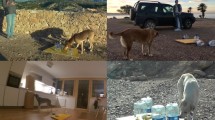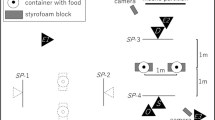Abstract
Dogs, although very skilled in social-communicative tasks, have shown limited abilities in the domain of physical cognition. Consequently, several researchers hypothesized that domestication enhanced dogs’ cognitive abilities in the social realm, but relaxed selection on the physical one. For instance, dogs failed to demonstrate means-end understanding, an important form of relying on physical causal connection, when tested in a string-pulling task. Here, we tested dogs in an “on/off” task using a novel approach. Thirty-two dogs were confronted with four different conditions in which they could choose between two boards one with a reward “on” and another one with a reward “off” (reward was placed next to the board). The dogs chose the correct board when (1) both rewards were placed at the same distance from the dog, when (2) the reward placed “on” the board was closer to the dog, and (3) even when the reward placed “off” the board was much closer to the dog and was food. Interestingly, in the latter case, dogs did not perform above chance, if instead of a direct reward, the dogs had to retrieve an object placed on the board to get a food reward. In contrast to previous string-pulling studies, our results show that dogs are able to solve a means-end task even if proximity of the unsupported reward is a confounding factor.



Similar content being viewed by others
References
Auersperg AMI, Gajdon GK, Huber L (2009) Kea (Nestor notabilis) consider spatial relationships between objects in the support problem. Biol Lett 5:455–458
Bird CD, Emery NJ (2010) Rooks perceive support relations similar to six-month-old babies. Proc R Soc Lond Ser B-Biol Sci 277:147–151
Boysen ST, Mukobi KL, Berntson GG (1999) Overcoming response bias using symbolic representations of number by chimpanzees (Pan troglodytes). Anim Learn Behav 27:229–235
Bratman M (1981) Intention and means-end reasoning. Philos Rev 90:252–265
Bräuer J, Kaminski J, Riedel J, Call J, Tomasello M (2006) Making inferences about the location of hidden food: social dog, causal ape. J Comp Psych 120:38–47
Cacchione T, Krist H (2004) Recognizing impossible object relations: intuitions about support in chimpanzees (Pan troglodytes). J Comp Psych 118:140–148
Call J (2006) Descartes’ two errors: reason and reflection in the great apes. In: Hurley S, Nudds M (eds) Rational animals? Oxford University Press, Oxford, pp 219–234
Collier-Baker E, Davis JM, Suddendorf T (2004) Do dogs (Canis familiaris) understand invisible displacement? J Comp Psych 118:421–433
de Mendonca-Furtado O, Ottoni EB (2008) Learning generalization in problem solving by a blue-fronted parrot (Amazona aestiva). Anim Cogn 11:719–725
Deacon TW (1997) The symbolic species: the co-evolution of language and the brain. Norton, New York
Diamond A (1990) Developmental time course in human infants and infant monkeys, and the neural basis of the inhibitory control of reaching. In: Diamond A (ed) The development and neural bases of higher cognitive functions. New York Academy of Sciences, New York, pp 637–676
Dickinson A (1980) Contemporary animal learning theory. Cambridge University Press, Cambridge, UK
Erdohegyi A, Topál J, Virányi Zs, Miklósi Á (2007) Dog-logic: inferential reasoning in a two-way choice task and its restricted use. Anim Behav 74:725–737
Fiset S, LeBlanc V (2007) Invisible displacement understanding in domestic dogs (Canis familiaris): the role of visual cues in search behavior. Anim Cogn 10:211–224
Fiset S, Gagnon S, Beaulieu C (2000) Spatial encoding of hidden objects in dogs (Canis familiaris). J Comp Psych 114:315–324
Frank H (1980) Evolution of canine information processing under conditions of natural and artificial selection. Zeitschrift für Tierpsychologie 5:389–399
Hare B, Tomasello M (2005) Human-like social skills in dogs? TRENDS Cogn Sci 9:439–444
Hare B, Brown M, Williamson C, Tomasello M (2002) The domestication of social cognition in dogs. Science 298:1634–1636
Hauser MD, Kralik J, Botto-Mahan C (1999) Problem solving and functional design features: experiments on cotton-top tamarins, Saguinus oedipus oedipus. Anim Behav 57:565–582
Heinrich B (1995) An experimental investigation of insight in Common Ravens (Corvus corax). Auk 112:994–1003
Hemmer H (1990) Domestication. The decline of environmental appreciation. Cambridge University Press, Cambridge
Herre W, Röhrs M (1973) Haustiere-Zoologisch Gesehen. Gustav Fischer, Stuttgart
Herrmann E, Wobber V, Call J (2008) Great apes’ (Pan troglodytes, Pan paniscus, Gorilla gorilla, Pongo pygmaeus) understanding of tool functional properties after limited experience. J Comp Psych 122:220–230
Irie-Sugimoto N, Kobayashi T, Sato T, Hasegawa T (2008) Evidence of means—end behavior in Asian elephants (Elephas maximus). Anim Cogn 11:359–365
Köhler W (1927) The mentality of apes. Vintage Books, New York
Kralik JD, Hauser MD, Zimlicki R (2002) The relationship between problem solving and inhibitory control: cotton-top tamarin (Saguinus oedipus) performance on a reversed contingency task. J Comp Psych 116:39–50
Marshall-Pescini S, Valsecchi P, Petak I, Accorsi PA, Previde EP (2008) Does training make you smarter? The effects of training on dogs’ performance (Canis familiaris) in a problem- solving task. Behav Process 78:449–454
McCall CA, Burgin SE (2002) Equine utilization of secondary reinforcement during response extinction and acquisition. Appl Anim Behav Sci 78:253–262
Miklósi Á, Soproni K (2006) A comparative analysis of animals’ understanding of the human pointing gesture. Anim Cogn 9:81–94
Miklósi Á, Polgardi R, Topál J, Csányi V (1998) Use of experimenter-given cues in dogs. Anim Cogn 1:113–121
Miklósi Á, Kubinyi E, Topál J, Gácsi M, Virányi Zs, Csányi V (2003) A simple reason for a big difference: wolves do not look back at humans but dogs do. Curr Biol 13:763–766
Osthaus B, Lea SEG, Slater AM (2003) Training influences problem-solving abilities in dogs (Canis lupus familiaris). In: Proceedings of Annual BSAS Conference. p 103
Osthaus B, Lea SEG, Slater AM (2005) Dogs (Canis lupus familiaris) fail to show understanding of means-end connections in a string-pulling task. Anim Cogn 8:37–47
Piaget J (1952) The origins of intelligence in children. International University Press, New York
Pongrácz P, Miklósi Á, Kubinyi E, Gurobi K, Topál J, Csányi V (2001) Social learning in dogs: the effect of a human demonstrator on the performance of dogs in a detour task. Anim Behav 62:1109–1117
Povinelli DJ (2000) Folk physics for apes. Oxford University Press, New York
Pryor K (2009) Reaching the animal mind: clicker training and what it teaches us about all animals. Scribner, New York
R Development Core T (2009) R: a language and environment for statistical computing. R Foundation for Statistical Computing, Vienna, Austria. http://www.R-project.org
Range F, Heucke SL, Gruber C, Konz A, Huber L, Zs Virányi (2009) The effect of ostensive cues on dogs’ performance in a manipulative social learning task. Appl Anim Behav Sci 120:170–178
Santos LR, Rosati A, Sproul C, Spaulding B, Hauser MD (2005) Means-means-end tool choice in cotton-top tamarins (Saguinus oedipus): finding the limits on primates’ knowledge of tools. Anim Cogn 8:236–246
Schmidt GF, Cook RG (2006) Mind the gap: means-end discrimination by pigeons. Anim Behav 71:599–608
Soproni K, Miklósi Á, Topál J, Csányi V (2001) Comprehension of human communicative signs in pet dogs (Canis familiaris). J Comp Psych 115:122–126
Thorndike EL (1898) Animal intelligence: an experimental study of the associative processes in animals. Psychol Rev Monogr Suppl 2
Tomasello M, Call J (1997) Primate cognition. Oxford University Press, Oxford
Topál J, Miklósi Á, Csányi V (1997) Dog-human relationship affects problem solving behavior in the dog. Anthrozoos 10:214–224
Topál J, Kubinyi E, Gácsi M, Miklósi Á (2005) Obeying social rules: a comparative study on dogs and humans. J Cult Evol Psych 3:213–237
Udell MAR, Dorey NR, Wynne CDL (2010) What did domestication do to dogs? A new account of dogs’ sensitivity to human actions. Biol Rev 85:327–345
Virányi Z, Gácsi M, Kubinyi E, Topál J, Belényi B, Ujfalussy D, Miklósi Á (2008) Comprehension of human pointing gestures in young human-reared wolves and dogs. Anim Cogn 11:373–387
Vlamings P, Uher J, Call J (2006) How the great apes (Pan troglodytes, Pongo pygmaeus, Pan paniscus, and Gorilla gorilla) perform on the reversed contingency task: The effects of food quantity and food visibility. J Exp Psych-Anim Behav Process 32:60–70
Vonk J, Subiaul F (2009) Do chimpanzees know what others can and cannot do? Reasoning about ‘capability’. Anim Cogn 12:267–286
Watson JS, Gergely G, Csanyi V, Topal J, Gacsi M, Sarkozi Z (2001) Distinguishing logic from association in the solution of an invisible displacement task by children (Homo sapiens) and dogs (Canis familiaris): Using negation of disjunction. J Comp Psych 115:219–226
Werdenich D, Huber L (2006) A case of quick problem solving in birds: string pulling in keas, Nestor notabilis. Anim Behav 71:855–863
Whitt E, Douglas M, Osthaus B, Hockin I (2009) Domestic cats (Felis catus) do not show causal understanding in a string-pulling task. Anim Cogn 12:739–743
Wobber V, Hare B (2009) Testing the social dog hypothesis: are dogs also more skilled than chimpanzees in non-communicative social tasks? Behav Process 81:423–428
Wynne CDL, Udell MAR, Lord KA (2008) Ontogeny’s impact on human–dog communication. Anim Behav 76:e1–e4
Acknowledgments
The project is financially supported by Austrian Science Fund (FWF) projects P21418 and P21244 (FR). We thank Corsin Müller for helping with the analyses, the dog owners for participating, and Daniel Povinelli and three referees for helpful comments on an earlier version of this manuscript. We further thank a private sponsor and Royal Canin for financial support of the Clever Dog Lab.
Conflict of interest
We declare that all experiments conducted in this study comply with the current laws of Austria where they were performed and that the authors have no conflict of interest.
Author information
Authors and Affiliations
Corresponding author
Rights and permissions
About this article
Cite this article
Range, F., Hentrup, M. & Virányi, Z. Dogs are able to solve a means-end task. Anim Cogn 14, 575–583 (2011). https://doi.org/10.1007/s10071-011-0394-5
Received:
Revised:
Accepted:
Published:
Issue Date:
DOI: https://doi.org/10.1007/s10071-011-0394-5




